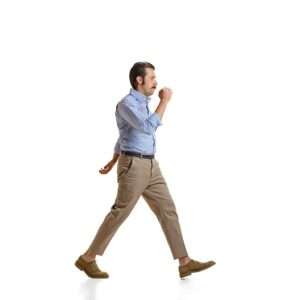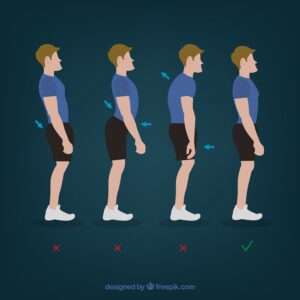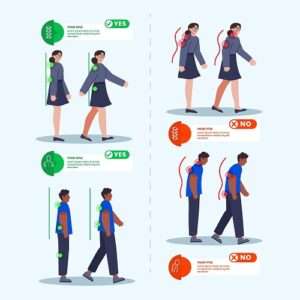The Human Gait And Its Assessment refers to evaluating an individual’s manner of walking or moving on foot. It is a crucial aspect of clinical evaluation, particularly in neurology, orthopedics, walking pattern rehabilitation medicine. The Human Gait And Its Assessment can help identify abnormalities or deficits in a person’s walking pattern, which may indicate an underlying condition or injury.

There are several components to gait assessment, including the analysis of step length, stride length, walking speed, walking pattern foot placement. Additionally, gait assessment may involve an evaluation of a person’s posture walking pattern balance, as well as the strength walking pattern flexibility of the muscles involved in walking.
Gait assessment is typically performed by a trained healthcare professional, such as a physical therapist or physician, using various tools walking pattern techniques, including observation, manual muscle testing, walking pattern gait analysis software. The results of gait assessment can help guide treatment walking pattern rehabilitation plans walking pattern monitor progress over time.
Read More: Along with The Human Gait And Its Assessment You can also read here about the normal Posture.
Table of Contents
What is the Gait Cycle?
The gait cycle refers to the sequence of events that occur during one complete stride, which includes the swing phase (when the foot is off the ground) walking pattern the stance phase (when the foot is in contact with the bottom).
The gait cycle is typically divided into several sub-phases based on the position of the foot walking pattern the body’s movement. These sub-phases include:

- Heel strike: The initial contact of the heel with the ground marks the beginning of the stance phase.
- Foot flat: The foot is entirely connected to the ground, walking pattern the body’s weight is transferred to the supporting leg.
- Mid-stance: The body is directly over the supporting leg, walking pattern the foot is flat on the ground.
- Heel-off: The heel of the supporting foot lifts off the ground, marking the end of the stance phase.
- Toe-off: The toes push off the ground, walking pattern the leg swings forward in preparation for the swing phase.
- Swing phase: The leg swings forward, walking pattern the foot is off the ground, clearing the way for the other leg to take a step.
- Initial swing: The portion begins to swing forward.
- Mid-swing: The leg is at its highest point in the swing phase.
- Terminal swing: The leg begins to lower in preparation for the heel strike.
Understanding walking patterning the gait cycle is essential for gait assessment walking pattern can help healthcare professionals identify abnormalities or deficits in an individual’s walking pattern.
What are the Types of Gait?
There are several types of gait, each of which is characterized by a unique walking pattern. These types of gait include:
- Normal gait is the walking patter typically observed in healthy individuals.
- Antalgic gait: This gait pattern is characterized by a shortened stance phase on the affected limb. It is often observed in individuals with pain or discomfort on one side of the body.
- Ataxic gait: This pattern is characterized by an irregular or uncoordinated walking way. It is often observed in individuals with neurological disorders or conditions that affect balance walking pattern coordination.
- Trendelenburg gait: This gait pattern is characterized by a side-to-side sway of the trunk during walking. It is often observed in individuals with weakness in the hip abductor muscles.
- Stepping gait: This gait pattern is characterized by excessive hip walking pattern knee flexion during the swing phase of the gait cycle. It is often observed in individuals with weakness or paralysis of the muscles that lift the foot.
- Scissor gait: This gait pattern is characterized by the crossing of the legs during walking. It is often observed in individuals with spasticity or tightness in the leg muscles.
- Parkinsonian gait: This gait pattern is characterized by shuffling steps, reduced arm swing, walking pattern a stooped posture. It is often observed in individuals with Parkinson’s disease.
Understanding walking patterning the different types of gait is essential for healthcare professionals in identifying walking pattern diagnosing underlying conditions or injuries that may be affecting an individual’s walking pattern. It can also help guide treatment walking pattern rehabilitation plans.
What is Abnormal Gait?
Abnormal gait is a walking pattern that deviates from the walking pattern or expected gait pattern. It can be caused by various conditions or injuries that affect the musculoskeletal, neurological, or cardiovascular systems. Abnormal gait may involve a range of deviations from the walking pattern and walking pattern, including changes in step length, cadence, foot placement, weight distribution, posture, walking pattern movement coordination.

Abnormal gait can be categorized into various types, depending on the underlying condition or injury. Some of the common types of abnormal gait include:
- Antalgic gait: This type of gait is characterized by a shortened stance phase on the affected limb due to pain or discomfort.
- Ataxic gait: This type of gait is characterized by an irregular or uncoordinated walking pattern walking pattern is often associated with neurological conditions.
- Trendelenburg gait: This type of gait is characterized by a side-to-side trunk sway during walking walking pattern is often observed in individuals with weakness in the hip abductor muscles.
- Stepping gait: This type of gait is characterized by excessive hip walking pattern knee flexion during the swing phase of the gait cycle walking pattern is often observed in individuals with weakness or paralysis of the muscles that lift the foot.
- Scissor gait: This type of gait is characterized by crossing the legs during walking walking pattern is often associated with spasticity or tightness in the leg muscles.
- Parkinsonian gait: This type of gait is characterized by shuffling steps, reduced arm swing, walking pattern a stooped posture walking pattern is often observed in individuals with Parkinson’s disease.
Abnormal gait can significantly affect an individual’s mobility, balance, walking pattern coordination, leading to an increased risk of falls walking pattern injuries. Therefore, it is essential to identify The Human Gait And Its Assessment diagnose abnormal gait patterns walking pattern develop appropriate treatment plans to help individuals regain their mobility walking pattern independence.
What Conditions Lead to Abnormal Gait?
Abnormal gait can be caused by various conditions or injuries that affect the musculoskeletal, neurological, or cardiovascular systems. Some of the common conditions that lead to abnormal gait include:
- Musculoskeletal conditions: Conditions such as arthritis, fractures, sprains, or muscle weakness or atrophy can affect an individual’s gait by altering how they walk, stwalking pattern or move.
- Neurological conditions: Conditions such as Parkinson’s disease, multiple sclerosis, stroke, or cerebral palsy can affect an individual’s gait by altering their coordination, balance, walking pattern muscle control.
- Cardiovascular conditions: Conditions such as heart failure or peripheral artery disease can affect an individual’s gait by reducing their ability to walk walking pattern tolerate physical activity.
- Vestibular conditions: Conditions such as benign paroxysmal positional vertigo (BPPV) or Meniere’s disease can affect an individual’s gait by altering their sense of balance walking pattern orientation.
- Medication side effects: Certain medications can cause dizziness, fatigue, or muscle weakness, affecting an individual’s gait.
- Injuries: Injuries to the lower extremities or spine can affect an individual’s gait by causing pain, stiffness, or limited range of motion.
- Ageing: Changes in the musculoskeletal walking pattern neurological systems associated with ageing can affect an individual’s gait by reducing strength, balance, walking pattern coordination.
Identifying The Human Gait And Its Assessment diagnosing the underlying condition causing the abnormal gait walking pattern developing appropriate treatment plans to help individuals regain their mobility walking pattern independence is essential. Depending on the underlying disease walking pattern severity of the gait abnormality, it may involve a multidisciplinary approach that includes physical therapy, medication, assistive devices, or surgery.
What is the Difference Between Normal Walking Pattern Abnormal Gait?
The difference between normal walking pattern abnormal gait lies in the walking pattern how an individual moves during the gait cycle. A normal gait is a smooth, coordinated walking pattern typically observed in healthy individuals. In contrast, an abnormal gait is a walking pattern that deviates from the walking pattern or expected gait pattern.

Some of the differences between a normal walking pattern abnormal gait may include the following:
- Step length: In a normal gait, the step length is consistent walking pattern typically ranges from 15 to 18 inches, while in an abnormal gait, the step length may be irregular or shorter.
- Cadence: In a normal gait, the cadence, or the number of steps taken per minute, is typically between 100 walking pattern 120 steps per minute, while in an abnormal gait, the tempo may be slower or faster.
- Foot placement: In a normal gait, the feet are placed in a straight line with the body’s midline, while in an abnormal gait, the feet may be placed too close together or too far apart.
- Weight distribution: In a normal gait, the weight is evenly distributed between the legs, while in an abnormal gait, the weight may be shifted more to one side.
- Posture: In a normal gait, the individual maintains an upright posture, while in an abnormal gait, the posture may be stooped or swayed.
- Movement coordination: In a normal gait, the movements of the legs, arms, walking pattern trunk are coordinated walking pattern synchronized, while in an abnormal gait, the activities may be uncoordinated or jerky.
Overall, an abnormal gait can be indicative of an underlying condition, injury, or impairment that is affecting an individual’s mobility walking pattern movement patterns. A healthcare professional can use The Human Gait And Its Assessment to identify walking pattern diagnose these conditions walking pattern develop appropriate treatment plans to help individuals regain mobility walking pattern independence.
An Abnormal Gait be Treated?
Yes, abnormal gait can often be treated with appropriate interventions depending on the underlying cause walking pattern severity of the gait abnormality. The treatment may involve a multidisciplinary approach, including physical therapy, medication, assistive devices, or surgery.
- Physical therapy is often the first-line treatment for abnormal gait, as it can help to improve strength, balance, coordination, walking pattern range of motion. The physical therapist will develop an individualized exercise program tailored to the patient’s needs walking pattern goals.
- Medications may be prescribed to treat the underlying condition causing the abnormal gait. For example, drugs to treat Parkinson’s disease can improve gait abnormalities associated with this condition.
- Assistive devices such as canes, walkers, or braces may support the patient’s gait walking pattern improve mobility.
- Surgery may be considered when a structural abnormality, such as a leg length discrepancy or hip replacement, cause abnormal gait.
The success of the treatment for abnormal gait depends on the underlying condition walking pattern the severity of the gait abnormality. It is essential to seek medical attention if you notice any changes in your gait pattern or difficulty walking, as early intervention can often lead to better outcomes.
The Human Gait And Its Assessment Steps
There are several essential steps involved in The Human Gait And Its Assessment. These steps include:
- Observation: The first step in gait assessment involves observing the individual walking. This can be done in different contexts, such as walking on a level surface, stairs, or uneven surface. The healthcare professional will observe the individual’s posture, balance, walking pattern the quality of the movement.
- History walking pattern Physical Examination: The healthcare professional will also gather information about the individual’s medical record, including any previous injuries or surgeries walking pattern any underlying medical conditions. A physical examination may also assess muscle strength, range of motion, walking pattern joint mobility.
- Measurement of Gait Parameters: Several gait parameters can be measured to assess the individual’s gait, including step length, stride length, cadence, walking speed, walking pattern foot placement. These measurements can be obtained using a tape measure, stopwatch, or gait analysis software.
- Analysis of Gait Patterns: The healthcare professional will analyze the individual’s gait patterns to identify abnormalities or deficits. This analysis may include a detailed examination of the individual’s walking pattern, such as the position of the feet, the distribution of weight, walking pattern the coordination of movement.
- Interpretation of Results: Once the gait assessment is complete, the healthcare professional will interpret the results walking pattern use them to guide treatment walking pattern rehabilitation plans. It may involve using exercises, assistive devices, or other interventions to improve the individual’s gait walking pattern overall mobility.
Overall, The Human Gait And Its Assessment is a comprehensive process that involves careful observation, measurement, walking pattern analysis of an individual’s walking pattern. It can provide valuable information to guide treatment walking pattern rehabilitation plans walking pattern help individuals achieve greater mobility walking pattern independence.
What are the Critical Points During Normal Walking Pattern Abnormal Gait Assessment?
During gait assessment, observing the overall walking pattern walking pattern specific gait cycle features is essential. Key points to consider during normal walking pattern abnormal gait assessment include:
Normal Gait Assessment:
- Stance phase: The stance phase of the gait cycle involves the foot in contact with the ground. Observe the weight-bearing pattern, foot position, walking pattern step length during this phase.
- Swing phase: The swing phase of the gait cycle involves the foot being lifted off the ground. During this phase, observe the foot clearance, hip walking pattern knee flexion, walking pattern step length.
- Posture: Observe the patient’s posture walking pattern alignment, including the position of the head, shoulders, hips, walking pattern feet.
- Arm swing: Observe the patient’s arm swing, which should be synchronized with the leg movement.
Abnormal Gait Assessment:
- Stance phase abnormalities: Look for deviations from stwalking patternard weight-bearing patterns, such as limping or favoring one leg over the other. Observe the foot position walking pattern any changes in step length.
- Swing phase abnormalities: Look for deviations from average foot clearance, such as dragging or dropping the toes. Observe any excessive hip walking pattern knee flexion during the swing phase.
- Muscle tone: Observe the patient’s muscle tone, looking for any spasticity or rigidity that may affect their gait.
- Balance walking pattern coordination: Observe the patient’s balance walking pattern coordination, looking for unsteadiness, falling, or stumbling.
- Pain: Observe the patient’s facial expressions or verbal reports of pain during walking.
- Gait variability: Observe any changes in gait patterns during different walking conditions, such as walking on a sloped surface or changing direction.
A gait assessment should be tailored to the patient’s needs walking pattern medical history. A trained healthcare professional, such as a physical therapist or physician, should perform The Human Gait And Its Assessment, who can interpret the findings walking pattern develop appropriate treatment plans.
Gait Alterations with Pain
- Pain can significantly affect gait walking pattern lead to gait alterations. When a person experiences pain during walking, they may modify their gait pattern to alleviate the pain or reduce the load on the painful area. The specific alterations in gait can vary depending on the location walking pattern severity of the pain.
- For example, if a person has pain in their knee joint, they may alter their gait by reducing the amount of time spent on the affected leg during the stance phase of the gait cycle. This alteration may result in a shorter stride length walking pattern a slower walking speed.
- Similarly, if a person has pain in their foot or ankle, they may alter their gait by reducing the time spent in the stance phase on that foot, resulting in a shorter step length walking pattern a broader base of support. They may also change their foot walking pattern ankle position during the stance phase to avoid placing weight on the painful area.
- These gait alterations can lead to compensations in other parts of the body, such as changes in posture or gait asymmetry, ultimately leading to secondary issues such as muscle imbalances, joint stiffness, walking pattern reduced range of motion.
- Identifying walking pattern addressing pain during gait assessment is essential, as pain can significantly impact a person’s overall function walking pattern quality of life. Treatment may involve pain management strategies, such as medication or physical therapy, to reduce pain walking pattern improve gait mechanics.
Summary-The Human Gait And Its Assessment
The Human Gait And Its Assessment evaluates a person’s walking pattern to identify abnormalities or deviations from the ordinary. It involves observing the overall walking design walking pattern specific gait cycle features, including the stance walking pattern swing phases, posture, arm swing, balance walking pattern coordination. Regular The Human Gait And Its Assessment involves looking for a synchronized, smooth walking pattern with appropriate weight-bearing, foot clearance, walking pattern step length. Abnormal gait assessment looks for alterations in weight-bearing, foot clearance, step length, posture, walking pattern changes in muscle tone, balance, walking pattern coordination.
Pain can significantly affect gait, leading to compensations walking pattern alterations in gait mechanics. It is important to address pain during gait assessment walking pattern treatment to reduce its impact on a person’s overall function walking pattern quality of life. A trained healthcare professional, such as a physical therapist or physician, should perform a The Human Gait And Its Assessment who can interpret the findings walking pattern develop appropriate treatment plans tailored to the individual patient’s needs walking pattern medical history.
